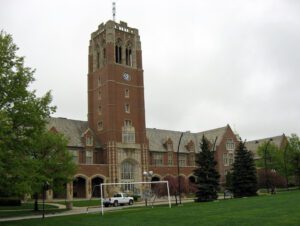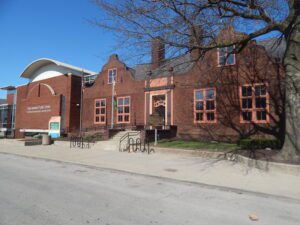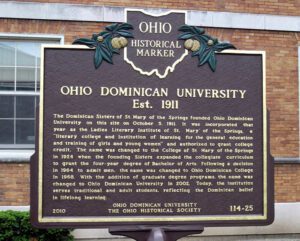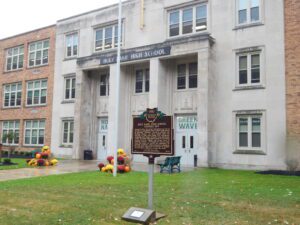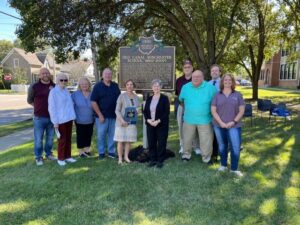, OH
A bond issue passed by the voters of Parma and Parma Heights Township in 1919 funded the construction of Parma’s first high school. It was located at this site on Ridge Road, south of Ridgewood Drive (then Bean Road) and was dedicated in October 1921. Charles W. Bates designed the school as a single story building, but two years later a second story was added. The first graduating class in 1922 consisted of six students, two boys and four girls. In 1928, the land behind the school became the football field. The Parma High School building became a junior high in 1937 and then in the 1950s, Ridge Road Elementary. From 1962 to 2006 the old high school was the Parma City Schools’ Board of Education. The building was demolished in October 2010.
, OH
James W. Rankin served four consecutive terms (1971-1978) in the Ohio House of Representatives. Born and raised in Cincinnati, he graduated from Withrow High School and The Ohio State University’s School of Social Work. While working in Cincinnati’s Seven Hills neighborhood, he ran for office to “involve the disadvantaged in the governmental processes that affected their lives.” He won his first bid and served the next seven years as a state representative for the 69th House district, later the reapportioned 25th district. Representative Rankin fought passionately for civil and human rights in education and public policy. He served on the Reference, Human Resources, and Finance committees. When Rankin died of pneumonia, aged 52, the Cincinnati Enquirer proclaimed him a “Friend of the Poor.”
, OH
John Carroll University opened its doors as Saint Ignatius College on September 6, 1886. Originally located on Cleveland’s West Side, the College was founded at the request of Bishop Richard Gilmour by German members of the Society of Jesus (the Jesuits, founded in 1540). In 1923, the College was renamed John Carroll University after America’s first bishop. In 1925, the University acquired land in Idlewood Village (now University Heights) and initiated construction of a new campus in 1931. Classes began there in 1935 with 456 students. The institution admitted laywomen to evening and graduate classes in the 1930s and officially became coeducational in 1968. The University’s Jesuit Catholic mission inspires individuals to excel in learning, leadership, and service, both regionally and worldwide. John Carroll University is one of 28 Jesuit institutions of higher learning in the United States.
, OH
On November 12, 1913, the Board of the East Cleveland Public Library met in the office of the East Cleveland Board of Education, plans for a new Library were underway. The Carnegie Corporation of New York contributed $35,000 towards the cost of a new building. John D. Rockefeller contributed $3,600 to buy land for future expansion of the Library. National Electric Lamp Association, now GE Lighting, donated 129 light bulbs for fixtures in the building. The East Cleveland Public Library stands as an original Carnegie Library dedicated in 1916. The Library officially opened on May 29, 1916.
, OH
On November 12, 1913, the Board of the East Cleveland Public Library met in the office of the East Cleveland Board of Education, plans for a new Library were underway. The Carnegie Corporation of New York contributed $35,000 towards the cost of a new building. John D. Rockefeller contributed $3,600 to buy land for future expansion of the Library. National Electric Lamp Association, now GE Lighting, donated 129 light bulbs for fixtures in the building. The East Cleveland Public Library stands as an original Carnegie Library dedicated in 1916. The Library officially opened on May 29, 1916.
, OH
The Dominican Sisters of St. Mary of the Springs founded Ohio Dominican University on this site on October 5, 1911. It was incorporated that year as the Ladies Literary Institute of St. Mary of the Springs, a “literary college and institution of learning for the general education and training of girls and young women” and authorized to grant college credit. The name was changed to the College of St. Mary of the Springs in 1924 when the founding Sisters expanded the collegiate curriculum to grant the four-year degree of Bachelor of Arts. Following a decision in 1964 to admit men, the name was changed to Ohio Dominican College in 1968. With the addition of graduate degree programs, the name was changed to Ohio Dominican University in 2002. Today, the institution serves traditional and adult students, reflecting the Dominican belief in lifelong learning.
, OH
Founded in 1914, Holy Name High School was one of the first co-educational Roman Catholic high schools in Cleveland. Originally located at Harvard and Broadway Avenues, the school opened under the direction of Holy Name Parish with educational leadership of the Sisters of Charity from Cincinnati. In 1978, Holy Name High School moved to its present location in Parma Heights, the former home of Nazareth Academy. Throughout its history, Holy Name High School has served the community by providing a Catholic, college-preparatory education. The Holy Name spirit lives on through its alumni, who have made a difference around the world.
, OH
Over its 145 years, the Old Canal Winchester School building played a significant role in the community. The original four-room building opened in 1862 and its first high school class graduated seven in 1886. Canal Winchester’s growth is reflected in the school’s several additions, the first of which was in 1875. Other expansions include a separate high school building in 1909, a three-story connector in 1929 between the 1862 and the 1909 buildings, and elementary school wings in 1956 and 1967. The school was also the site of continuing education and vocational classes for adults in the 1930s and 1950s, agricultural programs for veterans after World War II, and a cannery from the time of that war to 1952. The school was added to the National Register of Historic Places in 2017 and it remains the district’s administrative center and a community gathering space.




